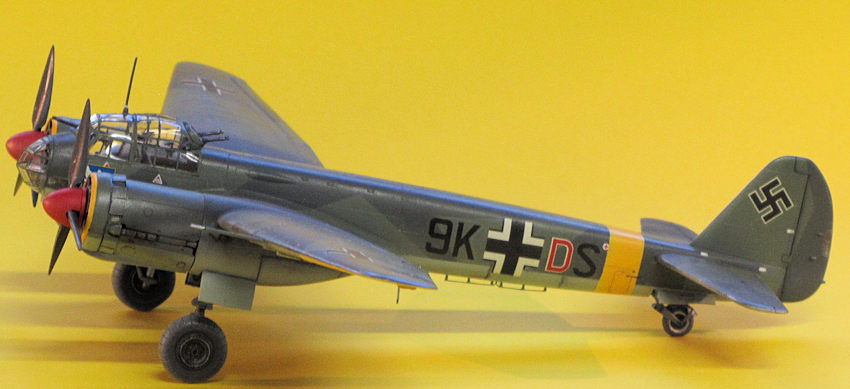
Hasegawa 1/72 Junkers Ju-88A-4
| KIT #: | 00555 |
| PRICE: | @$45.00 SRP ($19 on sale) |
| DECALS: | Three options |
| REVIEWER: | Ryan Grosswiler |
| NOTES: |

| HISTORY |
Few WWII aircraft have the distinction of being in
production and service with their original user from Day One to Day Last. The
Junkers Ju-88 was one of those 'sunrise to sunset' aircraft, the first dozen or
so just reaching IOC while the dawn of Sept 1, 1939 beamed brightly overhead as
the Reich sought to expand by force, while the last Ju-88G nightfighters fought
the final desperate air battles over Europe spring 1945, their bellies bathed
orange as the cities of the Reich burned and crumbled below them.
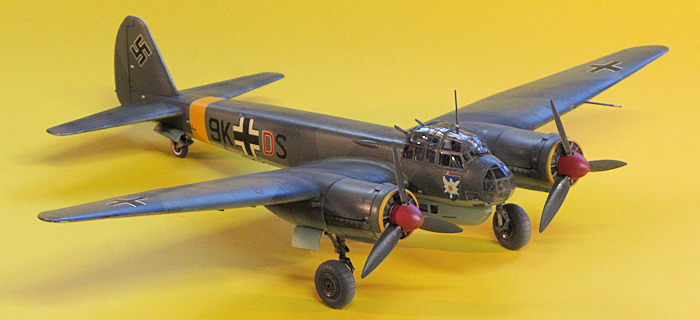 During the in-between time, the 15,000-odd examples of this bomber were adapted
to serve virtually every conceivable combat role from day fighter to high-speed
recon to close air support to torpedo plane. In the end it even served as a
guided missile, in its Mistel guise.
During the in-between time, the 15,000-odd examples of this bomber were adapted
to serve virtually every conceivable combat role from day fighter to high-speed
recon to close air support to torpedo plane. In the end it even served as a
guided missile, in its Mistel guise.
Much of this success was owed to the design's 'modularily': some good, high performance aerodynamic formulating embodied in a basic wing center section and fuselage which could be swapped out with different engines, wing tips, cockpit, and tail to stretch the design into any mission requirement, to the point of being transformed to a four-engine strategic bomber in the form of the unflown Ju-488. By accident or design, this all worked out so well that with the immediate obsolescence of the Do-17 and He-111, the chronic flammability problems of the He-177, and the Do-217's tedious development and production story, it was the Ju-88 which really provided the Luftwaffe with the bulk of its bomber force.
Probably few are aware that the design had some American DNA in it, with
engineering assistants Evers and Gassner, who had worked together at Fokker USA,
providing the latest structural know-how to Junkers Dipl. Ing. Ernst Zindel.
Also, like another American product, the B-26 Marauder, the first A-1 versions
developed a reputation of being tricky to fly, and required some minor design
changes for apprehensive crews to appreciate the aircraft for its combat
performance if not pleasant handling.
With its slight wing stretch, the "A-4" version depicted here was the result of this adaptation, and ended up being the main bomber variant. Coming into service in the spring of 1941, it remained in use for the rest of the war, including little-known production and extensive service use by the French following liberation. What-if idea: Indochina Ju-88s! Darn that A-26.
| THE KIT |
For decades, this was the single most
underserved WWII subject in any scale. The 1950s and '60s gave us the following
in 1/72, or thereabouts: Lindberg had a comically erroneous "A", Frog had
another "A" featuring some glaring cross-section problems around the forward
fuselage, canopy, and engines, Airfix still one more "A", too tall on its gear
and engine cowls too pointy, and Revell came out with a "G"; too flat through
the cockpit. The options were so rife with True Modelling Tragedy that Ray
 Rimmel even published a 1980 article in Scale Models detailing a harrowing
procedure for producing an acceptable Ju-88A by
mishmoshing the Airfix kit with an Italerei Ju-188
and other assorted bits by busting out your razor saw and plunging into a lot of
cutting and filling and sanding. Italerei rescued
the situation in the early 90s with a series of round-tail '88s, but even these
suffered from a fuselage that was noticeably too square, landing gear legs way
too long, and blah raised surface detail. AMT came out with an even more
comprehensive series, (including the square-tailed G) and recessed detail, but
many of the same problems. This situation remained until the advent in 2006 of
the kit reviewed here. Good, cheaper Ju-88s have come out since from Zvezda and
Revell GmbH*, but a very enticing deal online wooed me to go Hasegawa's route
and buy two.
Rimmel even published a 1980 article in Scale Models detailing a harrowing
procedure for producing an acceptable Ju-88A by
mishmoshing the Airfix kit with an Italerei Ju-188
and other assorted bits by busting out your razor saw and plunging into a lot of
cutting and filling and sanding. Italerei rescued
the situation in the early 90s with a series of round-tail '88s, but even these
suffered from a fuselage that was noticeably too square, landing gear legs way
too long, and blah raised surface detail. AMT came out with an even more
comprehensive series, (including the square-tailed G) and recessed detail, but
many of the same problems. This situation remained until the advent in 2006 of
the kit reviewed here. Good, cheaper Ju-88s have come out since from Zvezda and
Revell GmbH*, but a very enticing deal online wooed me to go Hasegawa's route
and buy two.
Standard modern Hasegawa fare here. Spilling out the box contents for inspection
and opening various bags yields you a big pile of grey sprues large and small
featuring some petite recessed detail, modular construction mimicking that of
the real thing and hinting at the many other versions which have emerged since.
Lots of unused parts.
| CONSTRUCTION |
Hasegawa's assembly sequence is fairly reasonable and there are no real
problems. Just leave off the small do-dads at least until main assembly is
complete. Also, attach the wingtips to the top main wing
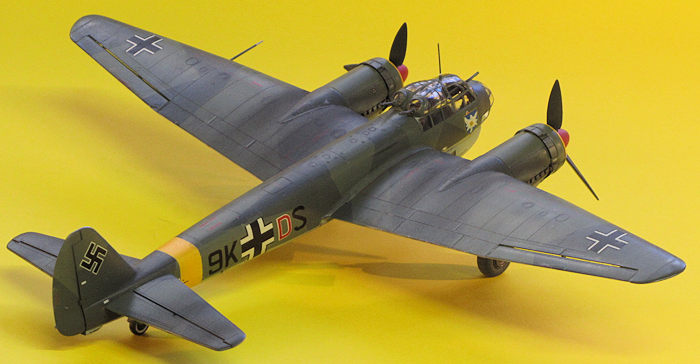 parts first, ensuring a
flush surface from one to the other, before gluing the bottom wing parts to the
top. A gap in the wing leading edge is much easier to deal with than a
discontinuity in the upper camber of the wing. Be prepared to do some filling
and sanding around the engine firewall part, too. These modular molds always
come at a cost of ease of assembly.
parts first, ensuring a
flush surface from one to the other, before gluing the bottom wing parts to the
top. A gap in the wing leading edge is much easier to deal with than a
discontinuity in the upper camber of the wing. Be prepared to do some filling
and sanding around the engine firewall part, too. These modular molds always
come at a cost of ease of assembly.
Don't waste too much time on cockpit detail: the dark color, small space (the
real Ju-88 cockpit was quite cramped), and all that framing effectively conceal
it. I just added some seatbelts and a bit of dry-brushing.
In the spirit of due diligence, partially courtesy the 'experten' of the online community, I will also pass along the following:
1) The main gear is about a scale 10" too far aft. I learned of this too late to
do anything about it, as the fix would involve moving the gear mounts buried
inside the wing about 1/8" forward. However, even though this little goof
manifests itself in the mains not being hard up against the forward wall of the
wheel well, it's really not that noticeable and I opted to shrug it off and move
forward.
2) Molding limitations make the dive brakes and bomb fins way too thick. Both
look like they've been cut from 3" pig iron. The dive brakes were therefore
carefully sanded down until they were translucent-thin and new bomb fins were
cut from .010" styrene sheet using the ki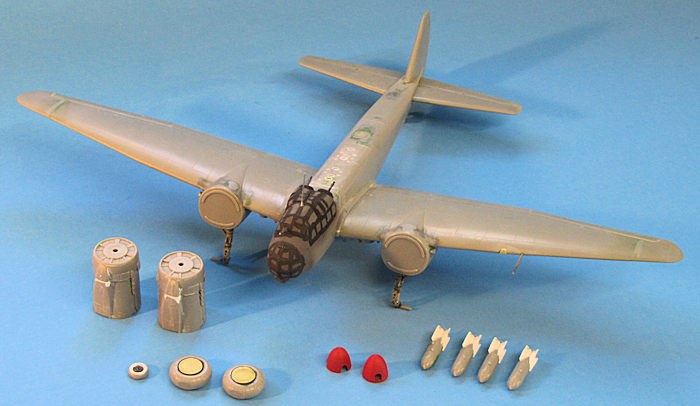 ts ones as patterns. A pain in the arse,
to be sure, but a huge improvement
in the looks department down below. While I was at it, I made up an external
load of 4 x SC250 bombs, stealing the second pair from the other kit I ordered.
This seemed to be the more standard load according to period photos, and I found
the homogeneous stores more aesthetically pleasing than the 2x SC500/ 2x SC250
mix supplied with the kit.
ts ones as patterns. A pain in the arse,
to be sure, but a huge improvement
in the looks department down below. While I was at it, I made up an external
load of 4 x SC250 bombs, stealing the second pair from the other kit I ordered.
This seemed to be the more standard load according to period photos, and I found
the homogeneous stores more aesthetically pleasing than the 2x SC500/ 2x SC250
mix supplied with the kit.
3) The annular radiators lack depth, with the three 'deep' segments being on the same plane as the rest of the rest of the circumference. AIMS Models offers a resin correction for this very issue, but I simply gave these segments a darker wash and it looks fine.
4) The prominent fuel-cell access points aft of the cockpit are omitted. I
copied the A. Granger plans from the Aerodata book, attached that particular
detail to styrene sheet with Super 77 spray adhesive, and cut it out to create a
scribing template that can also be used in future repeats of the project. See
photo.
5) The main wheels miss the character of the originals with a hub that's too wide and prominent, but the color of the wheels and tires are so close that the discrepancy all but vanishes in the finishing process. Also, because I build my models to survive some handling by the uninformed, I replaced all Things That Stick Out with various brass and steel bits.
| COLORS & MARKINGS |
Eduard's masking set was used to deal with all that daunting canopy framework.
Three RLM 70/71/65 finishing options are supplied, including two that feature
toned-down national markings achieved by some innovative and well-rendered decal
layering. I opted for the KG51 "Edelweiss" of the box art since that particular
flower species features in an inside romance theme between my better half and I.
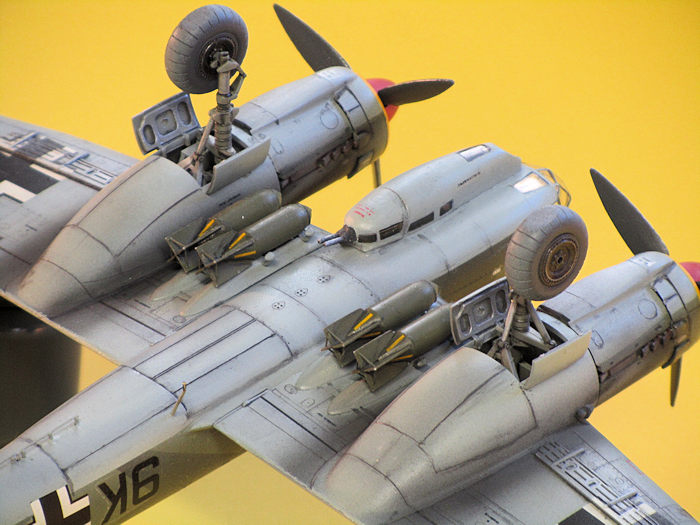 Paint was a custom mix of Testor's square-bottle enamels, and I followed
Hasegawa's outstanding painting diagrams to render that splinter scheme with
hours of careful masking. Remember that those patterns were precise! The decals
then went on following a coat or two of Future. All performed very well though I
didn't even bother trimming the borders. I also used a sheet from the defunct
Tally-Ho! to depict the rarely-seen full stencils of this aircraft. Another coat
of Future, and I grubbed things up with an enamel wash along all panel lines
wiped off after it dried an hour along the airflow with a Q-tip and a bit
of solvent. Exhaust streaks were shot with a very thin mixture of a sooty gray,
followed by a second pass with a whitish tan-grey. These aircraft were real
workhorses, especially in Russia, and got really messy in service...there is
scope to mess things up even more. One of the references listed below even
depicts an especially muddy, paint stripped, oil-stained, and generally
bedraggled example in flight and captions it with "...modellers who criticise
their fellows for excessive weathering might care to reflect on these two
photographs."
Paint was a custom mix of Testor's square-bottle enamels, and I followed
Hasegawa's outstanding painting diagrams to render that splinter scheme with
hours of careful masking. Remember that those patterns were precise! The decals
then went on following a coat or two of Future. All performed very well though I
didn't even bother trimming the borders. I also used a sheet from the defunct
Tally-Ho! to depict the rarely-seen full stencils of this aircraft. Another coat
of Future, and I grubbed things up with an enamel wash along all panel lines
wiped off after it dried an hour along the airflow with a Q-tip and a bit
of solvent. Exhaust streaks were shot with a very thin mixture of a sooty gray,
followed by a second pass with a whitish tan-grey. These aircraft were real
workhorses, especially in Russia, and got really messy in service...there is
scope to mess things up even more. One of the references listed below even
depicts an especially muddy, paint stripped, oil-stained, and generally
bedraggled example in flight and captions it with "...modellers who criticise
their fellows for excessive weathering might care to reflect on these two
photographs."
| CONCLUSIONS |
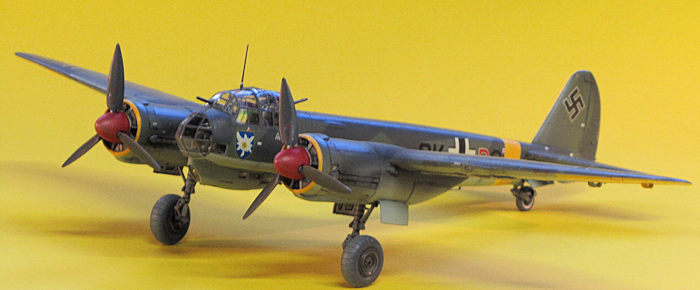 I'm not necessarily
a part of the starry-eyed Hasegawa fan club, but this is good, sound kit, and it
looks better than the Italeri example I built twenty years ago side-by side in
my lineup. The canopy parts are a bit optically distorted, my only standing
complaint. Only the fiddly nature of the modular moldings and high retail price
prevents me from recommending it to everybody--if you just want to whip out a
Ju-88 go for the new Revell or Zvezda examples. But this kit is the finest in
detail and scope--the available line now includes pretty much every Ju-88
sub-type, plus the Ju-188 and Mistel--so if you're willing to lay out the time
and money, it's worth it.
I'm not necessarily
a part of the starry-eyed Hasegawa fan club, but this is good, sound kit, and it
looks better than the Italeri example I built twenty years ago side-by side in
my lineup. The canopy parts are a bit optically distorted, my only standing
complaint. Only the fiddly nature of the modular moldings and high retail price
prevents me from recommending it to everybody--if you just want to whip out a
Ju-88 go for the new Revell or Zvezda examples. But this kit is the finest in
detail and scope--the available line now includes pretty much every Ju-88
sub-type, plus the Ju-188 and Mistel--so if you're willing to lay out the time
and money, it's worth it.
*some online wankery has been had moaning over the various errors in these kits as well: both look okay to my eye. There's also the Hobby Boss easy-assembly kit which looks surprisingly good.
| REFERENCES |
Various authors. Aerodata International: Bombers of World War II Squadron
Signal Publications, 1981
Griel, Manfred. Junkers Bombers Arms and Armor Press, 1987
Philpott, Brian. German Bombers over England Aztex Corporation, 1981
Filley, Brian Junkers Ju-88 in action Part 1 Squadron Signal, 1988
5 January 2017
Copyright ModelingMadness.com
If you would like your product reviewed fairly and fairly quickly, please contact the editor or see other details in the Note to Contributors.
Back to the Main Page Back to the Review Index Page Back to the Previews Index Page